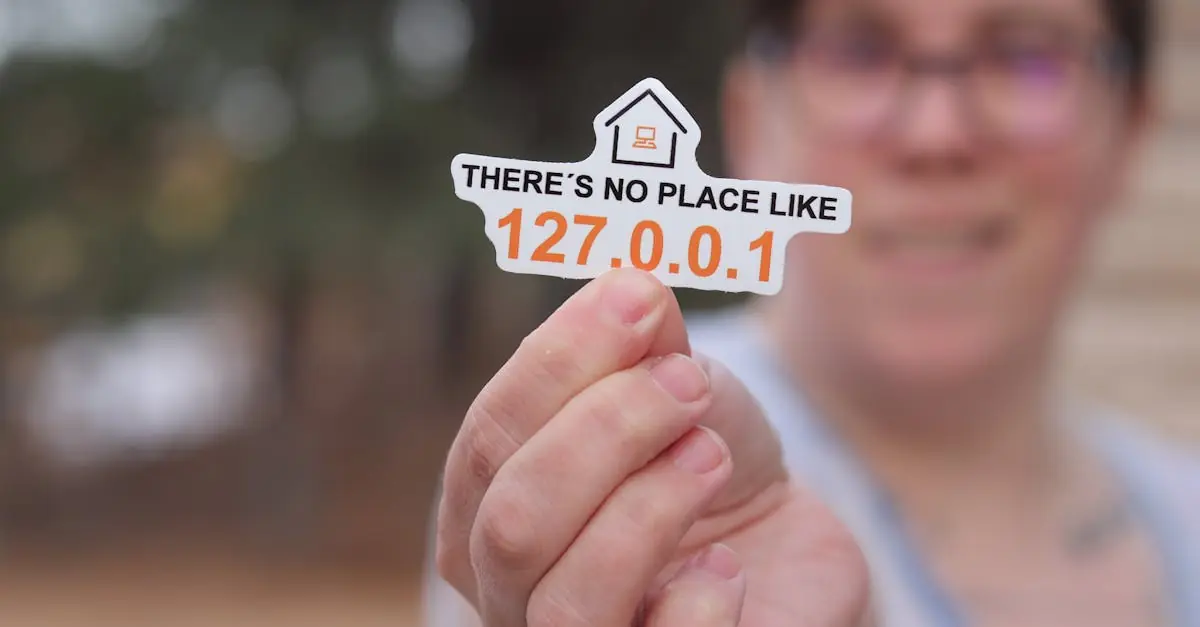Table of Contents
ToggleEvery iPhone user has faced that moment of confusion when trying to locate their IP address. It’s like searching for a needle in a haystack, but fear not—this guide’s got you covered. Whether you’re troubleshooting a connection issue or just curious about your device’s digital identity, knowing where to find that elusive number can make all the difference.
Understanding IP Addresses
IP addresses serve as unique identifiers for devices on a network. Each device connects to the internet using an individual IP address, allowing it to send and receive data. These addresses come in two types: IPv4 and IPv6. IPv4 addresses consist of four numbers separated by periods, while IPv6 addresses use a longer format with hexadecimal numbers.
Devices often use dynamic IP addresses assigned by routers. When a device connects to a network, it may receive a different IP address each time, unlike a static IP that remains unchanged. Users encounter IP addresses when troubleshooting network issues or configuring devices with online services.
Locating the IP address on an iPhone reveals crucial information. The address provides insight into the iPhone’s connection and location on the network. Most users find this information essential for setting up home networks or interacting with various online platforms.
To check the IP address on an iPhone, navigate to Settings, then select Wi-Fi. By tapping the info icon (i) next to the connected network, users can view their IP address and additional network details. Understanding this process enhances overall navigation of network settings.
Knowledge of IP addresses aids in various tasks. Network setup, device management, and security checks become streamlined with this information. Recognizing how to find an IP address empowers users to manage their connectivity effectively.
Finding Your IP Address on iPhone
Locating the IP address on an iPhone is straightforward. Users can access this information through various settings options on their devices.
Through Wi-Fi Settings
To find the IP address via Wi-Fi settings, navigate to the Settings app. Once in Settings, select Wi-Fi, where a list of available networks appears. Tap the info icon next to the connected network. The IP address displays prominently among other network details. For home networks, this method provides quick and easy access to the necessary information.
Using Cellular Data Settings
Finding the IP address while using cellular data involves a different path. Start by opening the Settings app again. From there, select Cellular and scroll down to Cellular Data Options. Users should then tap on the “Cellular Network” option. The IP address appears here, under the Data Network section. Knowing this IP address is useful for those who primarily rely on mobile data.
Checking Your IP Address in Other Apps
Finding an IP address on an iPhone can extend beyond basic settings. Several apps and methods make this process straightforward.
Network Utility Apps
Users can leverage network utility apps for enhanced functionalities. Apps like Fing or IP Scanner provide detailed information about connected devices on a network, including IP addresses. He or she can download these apps from the App Store. Upon opening the app, scanning the network typically reveals the user’s IP address alongside other network details. Many of these apps present intuitive interfaces, making them user-friendly. Opting for a network utility app can offer additional insights, like network speed and connected device lists.
Browser-Based Methods
Another effective way to find an IP address involves browser-based methods. Users can simply open Safari or any other web browser to access websites like whatismyip.com. These sites instantly display the public IP address. To view the local IP address, entering “ipconfig.me” can be helpful. He or she can utilize these websites easily without installing additional software. Browser-based methods deliver quick information about both local and public IP addresses, enhancing convenience for users.
Troubleshooting IP Address Issues
Determining an iPhone’s IP address can sometimes lead to connection problems. Verify the device’s connection by checking if it’s connected to the right network. An incorrect network may result in an IP address that doesn’t correspond with the user’s expectations.
Resetting network settings offers a solution for persistent issues. Users can navigate to Settings, select General, and tap on Reset. Choosing Reset Network Settings restores Wi-Fi networks and passwords, cellular settings, and VPN and APN settings, which might rectify any anomalies in IP address reporting.
Updating iOS can also resolve IP address issues. A current version often includes fixes for bugs that might affect network connections. Users can check for updates by going to Settings, selecting General, and then tapping on Software Update.
In some cases, disabling and re-enabling Wi-Fi may help. Turning off Wi-Fi and waiting a few seconds before reconnecting might enable the iPhone to obtain an IP address correctly from the router. Toggle the Wi-Fi switch located in Settings under Wi-Fi.
Checking router settings can uncover potential problems as well. Users accessing their router’s interface may find information on all connected devices and assigned IP addresses. This ensures the iPhone is receiving an appropriate address from the router.
Considering the use of DNS settings could also play a role. Users might want to experiment with public DNS servers like Google DNS (8.8.8.8) or OpenDNS (208.67.222.222). Updating these settings can sometimes improve connectivity and resolve underlying IP address issues.
Rebooting the router is another practical step. Power cycling the router resolves many minor network issues, which may affect IP addressing for connected devices.
Finding the IP address on an iPhone is a straightforward process that can significantly enhance a user’s understanding of their device’s connectivity. Whether using Wi-Fi or cellular data users can easily access this information through the Settings app. By knowing how to locate their IP address users can troubleshoot issues and manage their network more effectively.
Additionally utilizing apps or websites to find IP addresses can provide further insights into network performance. Staying informed about IP address types and troubleshooting methods ensures a smoother experience when connecting to the internet. With these tools in hand users are better equipped to navigate their digital environment confidently.




